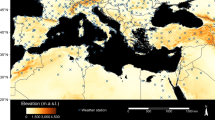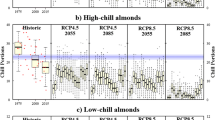Abstract
Anthropogenic climate change will influence winter chill accumulation, with future declines likely in temperate locations. However, these declines only translate as impacts when cultivar winter chilling requirements are not satisfied. This study presents a methodology to evaluate future impacts of declining winter chill through a cultivarspecific approach which is useful for growers, industry and policy-makers to develop adaptation strategies. A risk based system was applied to represent the likelihood of meeting cultivar chilling requirements using low, medium, medium-high and high risk ratings based on percentiles. This was combined with climate projection uncertainty graphically at 16 Australian growing districts historically (1981–2010) and for 2030, 2050 and 2090. The results demonstrated that impacts and likely adaptation options differed between cultivars, some recording limited risk at all sites out to 2090 ('Nonpareil' almond) whilst others recorded greater risk both historically and into the future ('Chandler' walnut). Notably, risk differed across sites and with the future time period. These results highlight which cultivars are susceptible to low winter chill conditions, where this risk does and does not manifest and the different time horizons at which the risk will materialise across Australia's main growing districts. Using this approach, changes in winter chill conditions are presented in a useable form which allows for appropriate climate adaptation strategies to be developed, securing the industries into the future.






Similar content being viewed by others
References
Alexander LV, Arblaster JM (2009) Assessing trends in observed and modelled climate extremes over Australia in relation to future projections. Int J Climatol 29(3):417–435
Allderman LA, Steyn WJ, Cook NC (2011) Growth regulator manipulation of apple bud dormancy progressions under conditions of inadequate winter chilling. S Afr J Plant Soil 28(2):103–109
Atkinson CJ, Brennan RM, Jones HG (2013) Declining chilling and its impact on temperate perennial crops. Environ Exp Bot 91:48–62
Baldocchi D, Wong S (2008) Accumulated winter chill is decreasing in the fruit growing regions of California. Clim Chang 87:S153–S166
Campoy JA, Ruiz D, Egea J (2011) Dormancy in temperate fruit trees in a global warming context: a review. Sci Hortic 130(2):357–372
Campoy JA, Ruiz D, Allderman L, Cook N, Egea J (2012) The fulfilment of chilling requirements and the adaptation of apricot (Prunus armeniaca L.) in warm winter climates: an approach in Murcia (Spain) and the Western Cape (South Africa). Eur J Agron 37(1):43–55
Charrier G, Bonhomme M, Lacointe A, Améglio T (2011) Are budburst dates, dormancy and cold acclimation in walnut trees (Juglans Regia L.) under mainly genotypic or environmental control? Int J Biometeorol 55(6):763–774
Chmielewski FM, Blümel K, Pálešová I (2012) Climate change and shifts in dormancy release for deciduous fruit crops in Germany. Clim Res 54(3):209–219
Clarke JM, Whetton PH, and Hennessy KJ (2011) Providing application-specific climate projections datasets: CSIRO’s climate futures framework. In: F. Chan, D. Marinova and R.S. Anderssen (Editors), MODSIM2011, 19th international congress on Modelling and simulation. Modelling and Simulation Society of Australia and New Zealand, Perth, Western Australia, pp. 2683–2690. ISBN: 978-0-9872143-1-7.
CSIRO and Bureau of Meteorology (2015) Climate change in Australia information for Australia’s natural resource management regions: technical report. CSIRO and Bureau of Meteorology, Australia
Darbyshire R, Webb L, Goodwin I, Barlow S (2011) Winter chilling trends for deciduous fruit trees in Australia. Agric For Meteorol 151:1074–1085
Darbyshire R, Webb L, Goodwin I, Barlow EWR (2013) Impact of future warming on winter chilling in Australia. Int J Biometeorol 57(3):355–366
Dennis FG (2003) Problems in standardizing methods for evaluating the chilling requirements for the breaking of dormancy in buds of woody plants. Hortscience 38(3):347–350
Erez A (2000) Bud dormancy; phenomenon, problems and solutions in the tropics and subtropics, temperate fruit crops in warm climates. Kluwer Academic Publishers, The Netherlands, pp. 17–48
Erez A, Fishman S, Linsley-Noakes GC, Allan P (1990) The dynamic model for rest completion in peach buds. Acta Hortic 279:165–174
Finetto GA (2014) An investigation of chilling requirement of some scab resistant apple cultivars in Po Valley. Acta Hortic:115–122
Fishman S, Erez A, Couvillon GA (1987a) The temperature dependence of dormancy breaking in plants—mathematical analysis of a two-step model involving a cooperative transition. J Theor Biol 124:473–483
Fishman S, Erez A, Couvillon GA (1987b) The temperature dependence of dormancy breaking in plants: computer simulation of processes studied under controlled temperatures. J Theor Biol 126(3):309–321
Ghariani K, Stebbins RL (1994) Chilling requirements of apple and pear cultivars. Fruit Varieties J 48(4):215–222
Guo L, Dai J, Ranjitkar S, Xu J, Luedeling E (2013) Response of chestnut phenology in China to climate variation and change. Agric For Meteorol 180:164–172
Guo L, Dai J, Wang M, Xu J, Luedeling E (2015) Responses of spring phenology in temperate zone trees to climate warming: a case study of apricot flowering in China. Agric For Meteorol 201:1–7
Hennessy K, Clayton-Greene K (1995) Greenhouse warming and vernalisation of high-chill fruit in southern Australia. Clim Chang 30:327–348
Jones D, Wang W, Fawcett R (2009) High-quality spatial climate data-sets for Australia. Aust Meteorol Oceanogr J 58:233–248
Joyce C (2015) PGA chill newsletter. Pistachio Growers’ Association, July, p. 6
Jun M, Knutti R, Nychka DW (2008) Spatial analysis to quantify numerical model bias and dependence: how many climate models are there? J Am Stat Assoc 103(483):934–947
Linvill DE (1990) Calculating chilling hours and chill units from daily maximum and minimum temperature observations. Hortscience 25(1):14–16
Luedeling E (2012) Climate change impacts on winter chill for temperate fruit and nut production: a review. Sci Hortic 144:218–229
Luedeling E, Brown P (2011) A global analysis of the comparability of winter chill models for fruit and nut trees. Int J Biometeorol 55(3):411–421
Luedeling E, Gebauer J, Buerkert A (2009a) Climate change effects on winter chill for tree crops with chilling requirements on the Arabian peninsula. Clim Chang 96:219–237
Luedeling E, Zhang M, McGranahan G, Leslie C (2009b) Validation of winter chill models using historic records of walnut phenology. Agric For Meteorol 149:1854–1864
Luedeling E, Zhang MH, Girvetz EH (2009c) Climatic changes lead to declining winter chill for fruit and nut trees in California during 1950-2099. PLoS One 4(7):e6166
Luedeling E, Girvetz EH, Semenov MA, Brown PH (2011) Climate change affects winter chill for temperate fruit and nut trees. PLoS One 6(5):e20155
Luedeling E, Guo L, Dai J, Leslie C, Blanke MM (2013) Differential responses of trees to temperature variation during the chilling and forcing phases. Agric For Meteorol 181:33–42
Mahmood K, Carew JG, Hadley P, Battey NH (2000) The effect of chilling and post-chilling temperatures on growth and flowering of sweet cherry (Prunus avium L.). J Hortic Sci Biotechnol 75(5):598–601
Measham PF, Quentin AG, MacNair N (2014) Climate, winter chill, and decision-making in sweet cherry production. Hortscience 49(3):254–259
Miranda C, Santesteban LG, Royo JB (2013) Evaluation and fitting of models for determining peach phenological stages at a regional scale. Agric For Meteorol 178-179:129–139
Moise A et al. (2015) Evaluation of CMIP3 and CMIP5 models over the Australian region to inform confidence in projections. Aust Meteorol Oceanogr J, (accepted).
Moss RH et al. (2010) The next generation of scenarios for climate change research and assessment. Nature 463(7282):747–756
Oukabli A, Bartolin S, Viti R (2003) Anatomical and morphological study of apple (Malus X domestica Borkh.) flower buds growing under inadequate winter chilling. J Hortic Sci Biotechnol 78(4):580–585
Palasciano M, Gaeta L (2012) Chilling requirements of ten sweet cherry cultivars grown in Apulia region (Southeast Italy). Palmero, Italy
Perez FJ, Ormeno JN, Reynaert B, Rubio S (2008) Use of the dynamic model for the assessment of winter chilling in a temperature and a subtropical climatic zone of Chile. Chilean J Agric Res 68:198–206
Petri JL, Leite GB (2004) Consequences of insufficient winter chilling on apple tree bud-break. Acta Hortic 662:53–60
Pistachio Growers’ Association (2015). Total Production of Pistachio. <http://www.pgai.com.au/wp-content/uploads/2013/01/Total_Production_of_Pistachio.pdf >
Pope K (2015) Fruit & nut crop chill portions requirements. The University of California, <http://fruitsandnuts.ucdavis.edu/Weather_Services/chilling_accumulation_models/CropChillReq/ >.
Ramírez L, Sagredo KX, Reginato GH (2010) Prediction models for chilling and heat requirements to estimate full bloom of almond cultivars in the Central Valley of Chile. Acta Hortic 872:107–112
Ruiz D, Campoy J, Egea J (2007) Chilling and heat requirements of apricot cultivars for flowering. Environ Exp Bot 61:254–263
Saure MC (1985) Dormancy release in deciduous fruit trees. Hortic Rev 7:239–300
Seif El-Yazal MA, Rady MM (2012) Changes in nitrogen and polyamines during breaking bud dormancy in " Anna" apple trees with foliar application of some compounds. Sci Hortic 136:75–80
Selvaraju R, Gommes R, Bernardi M (2011) Climate science in support of sustainable agriculture and food security. Clim Res 47(1–2):95–110
Smith I, Chandler E (2010) Refining rainfall projections for the Murray Darling Basin of south-east Australia-the effect of sampling model results based on performance. Clim Chang 102:377–393
Sunley RJ, Atkinson CJ, Jones HG (2006) Chill unit models and recent changes in the occurrence of winter chill and spring frost in the United Kingdom. J Hortic Sci Biotechnol 81(6):949–958
Viti R et al. (2010) Effect of climatic conditions on the overcoming of dormancy in apricot flower buds in two Mediterranean areas: Murcia (Spain) and Tuscany (Italy). Sci Hortic 124(2):217–224
Voller CFP (1986) Predicting rest-breaking: principles and problems. Deciduous Fruit Grower 36(8):302–308
Webb LB et al. (2012) Earlier wine grape ripening driven by climate warming and declines in soil water content. Nat Clim Chang 2:259–264
Whetton P, Hennessy K, Clarke J, McInnes K, Kent D (2012) Use of representative climate futures in impact and adaptation assessment. Clim Chang 115:433–442
Zhang J, Taylor C (2011) The dynamic model provides the best description of the chill process on ‘Sirora’ pistachio trees in Australia. Hortscience 46(3):420–425
Acknowledgments
The authors thank Mark O’Connell , Jennifer Whitney and Walnuts Australia for advice on cultivar selection and Australian growing regions. Funding for this research was provided by the Australian Department of Agriculture and Water Resources.
Author information
Authors and Affiliations
Corresponding author
Electronic supplementary material
ESM 1
Fig. 1 Projected chill conditions for 12 sites not included in Fig. 4. Black bars represent the historical range, blue and red bars represent best and worse-case scenarios for each project time period, respectively. Numbers across the range is the chill portion accumulation for the 10th and 90th percentiles. (GIF 108 kb)
ESM 2
(GIF 102 kb)
Rights and permissions
About this article
Cite this article
Darbyshire, R., Measham, P. & Goodwin, I. A crop and cultivar-specific approach to assess future winter chill risk for fruit and nut trees. Climatic Change 137, 541–556 (2016). https://doi.org/10.1007/s10584-016-1692-3
Received:
Accepted:
Published:
Issue Date:
DOI: https://doi.org/10.1007/s10584-016-1692-3




